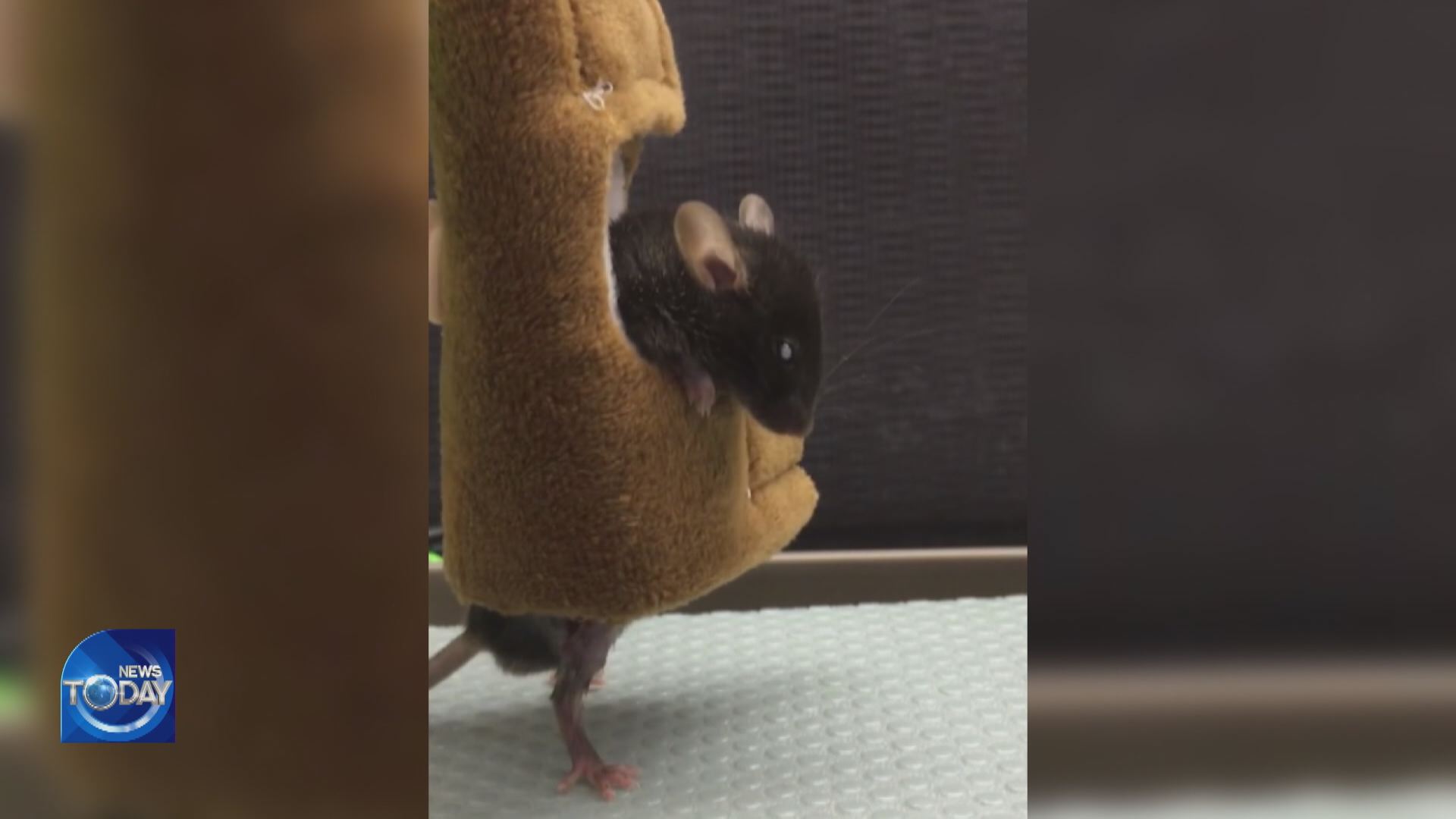DEVELOPMENT OF ARTIFICIAL NERVE
입력 2022.08.17 (14:58)
수정 2022.08.17 (16:45)
읽어주기 기능은 크롬기반의
브라우저에서만 사용하실 수 있습니다.
[Anchor Lead]
It's known to be extremely difficult to restore body parts that are paralyzed due to neural damage. Korean researchers have developed an artificial nerve that has succeeded in moving a paralyzed animal leg. The achievement is expected to have groundbreaking effects also in the treatment of people in the not so distant future.
[Pkg]
A lab mouse with spinal nerves that are temporarily numbed. Two legs have lost senses and energy. But slowly, they start to move. The leg movement picks up speed on a treadmill. The mouse even stretches the leg to kick a ball. This was made possible by artificial nerves attached to the mouse's body. Instead of the animal's paralyzed nerves, the artificial nerves relayed external stimuli to make the legs move. The new technology copies the structure of the nervous system consisting of neurons and synapses. When the body is stimulated using electrodes, artificial neurons and synapses exchange electric signals and enable muscular movement. This technology jointly developed by South Korean and American researchers has been published in the renowned journal Nature Biomedical Engineering.
[Soundbite] Prof. Lee Tae-woo(Seoul Nat’l Univ.) : "The technology provides a neural path that bypasses damaged nerves. The breakthrough is a result of existing biological and medical research combined with an engineering approach."
The research team applied the technology first on insects 4 years ago. The latest animal test delivered more sophisticated movements. Experts believe the team inched closer to realizing clinical testing on humans.
[Soundbite] Prof. Chung Chun-kee(Seoul Nat’l Univ.) : "The new technology will be groundbreaking for spinal and neural paralysis. The next step is waiting for an evaluation in clinical testing that shows the artificial nerves clearly work."
The new artificial nerve has raised expectations for paving new ways of treating rare neural ailments such as Lou Gehrig's and Parkinson's disease in the not too distant future.
It's known to be extremely difficult to restore body parts that are paralyzed due to neural damage. Korean researchers have developed an artificial nerve that has succeeded in moving a paralyzed animal leg. The achievement is expected to have groundbreaking effects also in the treatment of people in the not so distant future.
[Pkg]
A lab mouse with spinal nerves that are temporarily numbed. Two legs have lost senses and energy. But slowly, they start to move. The leg movement picks up speed on a treadmill. The mouse even stretches the leg to kick a ball. This was made possible by artificial nerves attached to the mouse's body. Instead of the animal's paralyzed nerves, the artificial nerves relayed external stimuli to make the legs move. The new technology copies the structure of the nervous system consisting of neurons and synapses. When the body is stimulated using electrodes, artificial neurons and synapses exchange electric signals and enable muscular movement. This technology jointly developed by South Korean and American researchers has been published in the renowned journal Nature Biomedical Engineering.
[Soundbite] Prof. Lee Tae-woo(Seoul Nat’l Univ.) : "The technology provides a neural path that bypasses damaged nerves. The breakthrough is a result of existing biological and medical research combined with an engineering approach."
The research team applied the technology first on insects 4 years ago. The latest animal test delivered more sophisticated movements. Experts believe the team inched closer to realizing clinical testing on humans.
[Soundbite] Prof. Chung Chun-kee(Seoul Nat’l Univ.) : "The new technology will be groundbreaking for spinal and neural paralysis. The next step is waiting for an evaluation in clinical testing that shows the artificial nerves clearly work."
The new artificial nerve has raised expectations for paving new ways of treating rare neural ailments such as Lou Gehrig's and Parkinson's disease in the not too distant future.
■ 제보하기
▷ 카카오톡 : 'KBS제보' 검색, 채널 추가
▷ 전화 : 02-781-1234, 4444
▷ 이메일 : kbs1234@kbs.co.kr
▷ 유튜브, 네이버, 카카오에서도 KBS뉴스를 구독해주세요!
- DEVELOPMENT OF ARTIFICIAL NERVE
-
- 입력 2022-08-17 14:58:05
- 수정2022-08-17 16:45:06

[Anchor Lead]
It's known to be extremely difficult to restore body parts that are paralyzed due to neural damage. Korean researchers have developed an artificial nerve that has succeeded in moving a paralyzed animal leg. The achievement is expected to have groundbreaking effects also in the treatment of people in the not so distant future.
[Pkg]
A lab mouse with spinal nerves that are temporarily numbed. Two legs have lost senses and energy. But slowly, they start to move. The leg movement picks up speed on a treadmill. The mouse even stretches the leg to kick a ball. This was made possible by artificial nerves attached to the mouse's body. Instead of the animal's paralyzed nerves, the artificial nerves relayed external stimuli to make the legs move. The new technology copies the structure of the nervous system consisting of neurons and synapses. When the body is stimulated using electrodes, artificial neurons and synapses exchange electric signals and enable muscular movement. This technology jointly developed by South Korean and American researchers has been published in the renowned journal Nature Biomedical Engineering.
[Soundbite] Prof. Lee Tae-woo(Seoul Nat’l Univ.) : "The technology provides a neural path that bypasses damaged nerves. The breakthrough is a result of existing biological and medical research combined with an engineering approach."
The research team applied the technology first on insects 4 years ago. The latest animal test delivered more sophisticated movements. Experts believe the team inched closer to realizing clinical testing on humans.
[Soundbite] Prof. Chung Chun-kee(Seoul Nat’l Univ.) : "The new technology will be groundbreaking for spinal and neural paralysis. The next step is waiting for an evaluation in clinical testing that shows the artificial nerves clearly work."
The new artificial nerve has raised expectations for paving new ways of treating rare neural ailments such as Lou Gehrig's and Parkinson's disease in the not too distant future.
It's known to be extremely difficult to restore body parts that are paralyzed due to neural damage. Korean researchers have developed an artificial nerve that has succeeded in moving a paralyzed animal leg. The achievement is expected to have groundbreaking effects also in the treatment of people in the not so distant future.
[Pkg]
A lab mouse with spinal nerves that are temporarily numbed. Two legs have lost senses and energy. But slowly, they start to move. The leg movement picks up speed on a treadmill. The mouse even stretches the leg to kick a ball. This was made possible by artificial nerves attached to the mouse's body. Instead of the animal's paralyzed nerves, the artificial nerves relayed external stimuli to make the legs move. The new technology copies the structure of the nervous system consisting of neurons and synapses. When the body is stimulated using electrodes, artificial neurons and synapses exchange electric signals and enable muscular movement. This technology jointly developed by South Korean and American researchers has been published in the renowned journal Nature Biomedical Engineering.
[Soundbite] Prof. Lee Tae-woo(Seoul Nat’l Univ.) : "The technology provides a neural path that bypasses damaged nerves. The breakthrough is a result of existing biological and medical research combined with an engineering approach."
The research team applied the technology first on insects 4 years ago. The latest animal test delivered more sophisticated movements. Experts believe the team inched closer to realizing clinical testing on humans.
[Soundbite] Prof. Chung Chun-kee(Seoul Nat’l Univ.) : "The new technology will be groundbreaking for spinal and neural paralysis. The next step is waiting for an evaluation in clinical testing that shows the artificial nerves clearly work."
The new artificial nerve has raised expectations for paving new ways of treating rare neural ailments such as Lou Gehrig's and Parkinson's disease in the not too distant future.
이 기사가 좋으셨다면
-
좋아요
0
-
응원해요
0
-
후속 원해요
0












![[속보] 17번째 세계유산 나왔다…‘반구천의 암각화’ 유네스코 세계유산 등재](/data/layer/904/2025/07/20250712_QIluYy.jpg)




이 기사에 대한 의견을 남겨주세요.